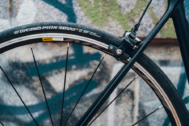Presta vs Schrader Valves: What are the main differences between these valve types?
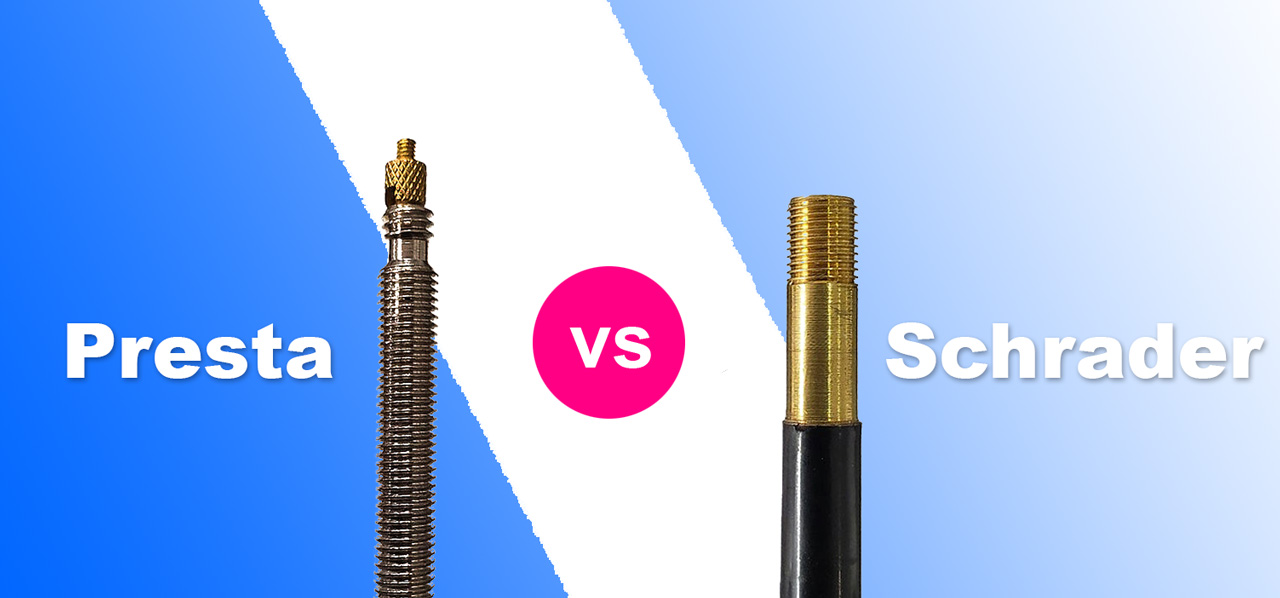
The question of Presta vs Schrader valves might not cross the minds of most cyclists until they face the decision of choosing rims and tubes compatible with one of these two types of bike valves.
Schrader and Presta valves are the most prevalent types of bike tire valves. While there are other varieties, chances are you’ll rarely, if ever, come across them.
Both valves serve the primary function of inflating and deflating your bicycle tires. However, they exhibit slight differences and possess unique advantages and disadvantages, making them more or less suitable for specific types of cyclists.
In this article, we will delve into the details of Presta and Schrader valves. We’ll clarify what they are, how they operate, and provide guidance on how to use each type effectively.
What Bike Tire Valve Types Exist?
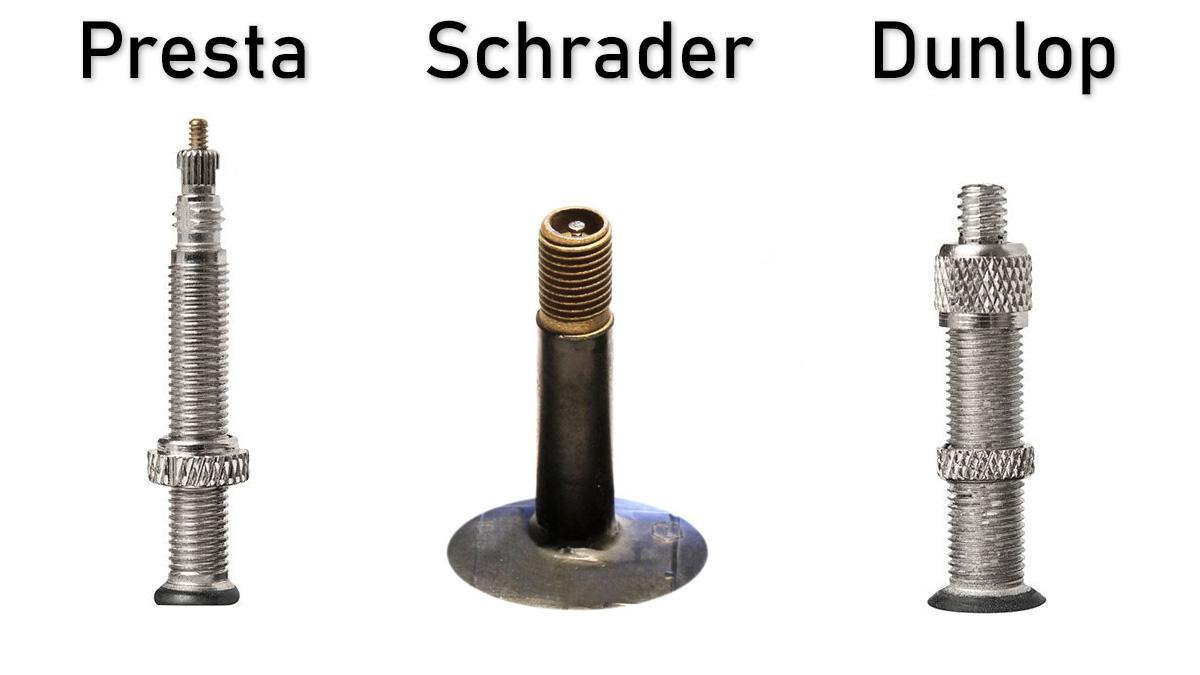
There are three main types of valves for bicycles: Presta, Schrader, and Dunlop. In this article, we discuss the Presta vs Shrader valve. Each valve works similarly – air pressure inside the tube keeps the valve closed, and you can release air by pushing the valve core inwards with a fingernail or small object.
When filling the tire up, you must hold the pump attachment onto the valve securely so you can pump air in without it escaping.
Clincher vs Tubular vs Tubeless Tires — All Differences Explained
Both Schrader and Presta valves are threaded on the outside so that you can seal them with a valve cap. Presta valves are often threaded on the outer wall all the way down the shaft so that you can use a locking screw to hold the valve in place. This is especially important on tubeless rims or if you’re using an incompatible rim with a large hole.
What Is a Presta Valve?
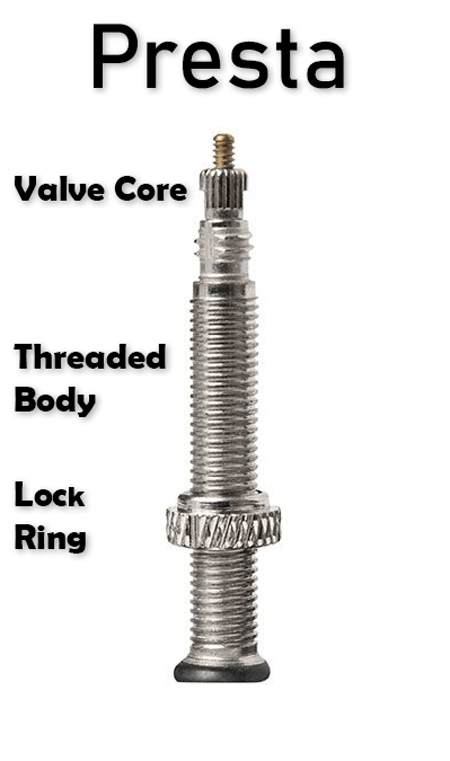
The Presta valve is commonly found on thinner tubes used for road bikes, touring bikes, fixies, and track bikes. However, some high-end mountain bikes have recently begun using Presta valves, especially ones with tubeless tires. Presta works better as a tubeless tire valve stem since it’s smaller and easier to secure in place.
Presta valves are thinner, lighter, and more fragile than Schrader valves, with better airflow control. They are popular on road bikes because they only require a small hole in the rim, meaning manufacturers can make thinner rims with lighter materials.
Moreover, the entire core of this valve type is removable, so it can be replaced or serviced.
Unlike a Schrader valve, a Presta valve has an additional screw nut attached to the valve core to stop dust from getting in. This must be unscrewed along with the Presta valve caps when inflating a Presta tube.
What Is a Schrader Valve?
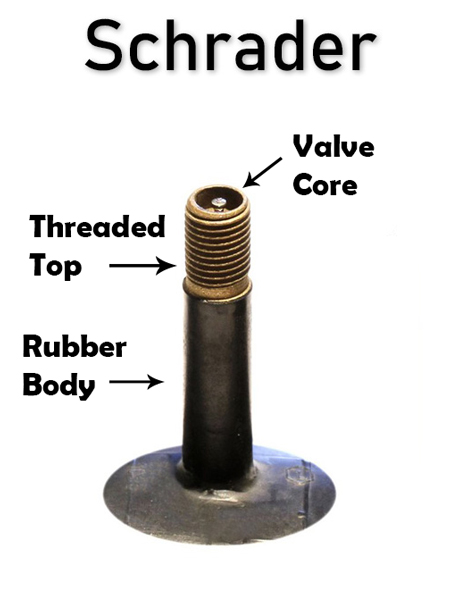
The Schrader bike valve is one of the most well-known valves found on mountain bikes, BMXs, hybrids, e-bikes, and a host of other bicycle types. Even motorbikes, car tires, and aircraft use the Schrader-style valve on their tires. They are the toughest, most affordable, and most widely used valves in the world.
The Schrader valve is characterized by a wide, round barrel tube with screw markings down the sides and a mechanical check valve in the center. The screw-on sides are used to secure a valve cap or attach a screw-on pump head for a tighter fit and are the same circumference from top to bottom. A spring within the Schrader check valves keeps it compressed so air can’t escape, and is depressed when a pump head is attached.
Are Dunlop Valves Still in Use?
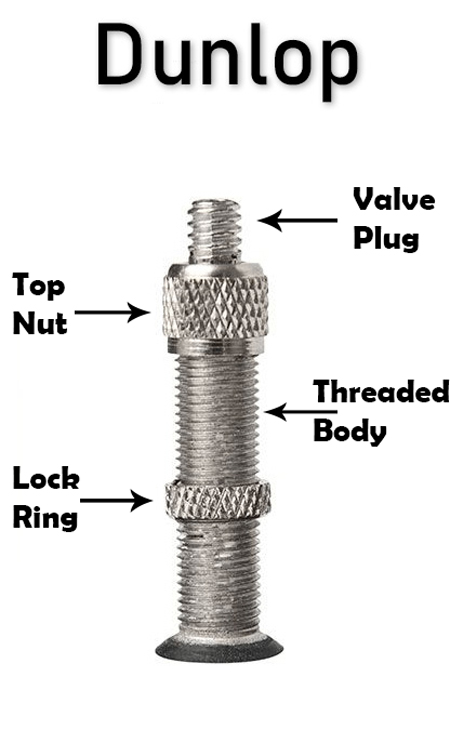
Dunlop valves are a rare type of bicycle tire valve that is practically non-existent in the US, and only seldomly used in Europe and parts of Asia. Its base is similar in size to a Schrader valve but with a pneumatic stem that is forced open by air when pumping. This makes it difficult to pump and almost impossible to control the airflow.
Although a new version with a spring-loaded stem is now available, Dunlop valves are rarely seen on modern bicycles. For this reason, we will only discuss Schrader and Presta valves in this article.
Presta vs. Schrader Valves: How Do They Differ?
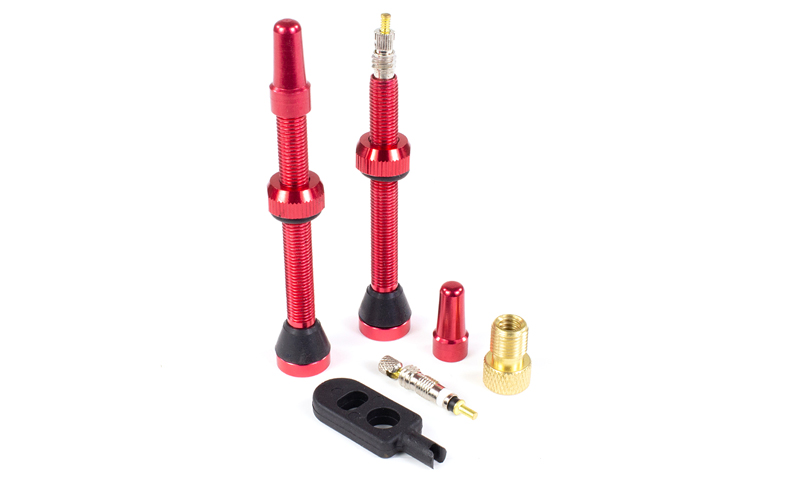
Tubeless Presta valve stem set. | Image source: Jenson USA
The fundamental difference between the Schrader valve vs Presta valve is the size and weight, with the much lighter Presta requiring a considerably smaller hole in the wheel rim compared to a Schrader rim. This may seem inconsequential but it makes a big difference on super-light carbon fiber wheels as the diameter of the hole can be smaller, which affects the rim strength.
It’s also easier to control airflow on a Presta valve, making it possible to set your tires to a very precise pressure. This is because the valve head closes almost instantly, leaving no gaps for air to escape.
However, Presta valves are weaker than Schrader valves and require a special type of bike pump or pump attachment. If you’re on a bike tour in a foreign country, it’s much easier to find spare tubes with Schrader valves and pumps that fit them, which are the main advantages of Schrader valves. They are also cheaper and longer-lasting than Presta valves.
Should You Use a Presta Valve or a Schrader Valve?
Most bicycles come with rims that only take one valve or the other, so in most cases, you don’t have a choice; unless you plan to replace your rims. If you get a road bike, it’ll ideally come with Presta valves, whereas a hybrid or MTB will probably come with Schrader valves.
However, there are some situations in which you may wish to change your valves. If you have a road bike that you plan to do long-distance touring on, it could be beneficial to change to rims that fit Schrader valves.
If you’re a serious mountain biker, you may wish to change to Presta valves to save on weight or better regulate the air in your tires. In short, Schrader valves are cheaper, stronger, and more available, but if you have specific requirements you could benefit from using Presta valves.
How to Inflate a Presta Valve and a Schrader Valve?

Image source: Stan’s NoTubes
Inflating a tire or tube using both Presta and Schrader valves is fairly simple, but there are some important things to pay attention to if you don’t want to encounter any issues down the road.
How to use a Schrader valve
Schrader valves are the easiest valves to operate, which is why they are so widely used, even on children’s bicycles. Follow these steps to pump up your tires using a Schrader valve:
- Unscrew the stem cap and ensure the valve is clean.
- If the tube isn’t new, gently push the inner pin with a pen or fingernail to release any trapped dirt.
- Attach your pump either by holding it in place or screwing it on if it has this functionality.
- Begin pumping while holding the pump head in place.
- Once the tube is inflated, replace the screw-on stem cap.
How to use a Presta valve
Presta valves are slightly more complex than Schrader but follow the same basic idea. These are the steps to pump up a Presta valve tube:
- Unscrew the stem cap and check the valve for dirt.
- Once clean, unscrew the valve core nut with your fingers. This is the small metal screw on the top of the valve stem.
- Push the valve stem down to release a burst of air that will clear any trapped dust.
- Using a Presta pump (or standard pump with Presta attachment), hold the pump head in place and begin pumping.
- Once the desired pressure is reached, remove the pump, screw the valve core nut, and replace the screw-on stem cap.
Installing a Tubeless Valve
Valves work in the same way whether on tubes or in a tubeless bike setup, the only difference is that a tubeless valve is attached directly to the inside of the rim rather than a tube. Presta valves are typically the preferred tubeless tire valve, but you can also use a fully threaded Schrader valve.
- After layering your tubeless tape in place, find the valve hole and puncture the tape with a pen or similar instrument.
- Slip the valve through the hole from the outside of the rim and tighten it in place using a screw-on lock nut.
- You need to make sure the valve is airtight, so use a spacer if the lock nut doesn’t screw flush with the rim.
- Then add tire sealant, adjust the tire, and add air until the tire is seated.
- It’s best to use high-volume floor pumps or an air compressor.
Presta Valve Pump and Schrader Valve Pump Differences
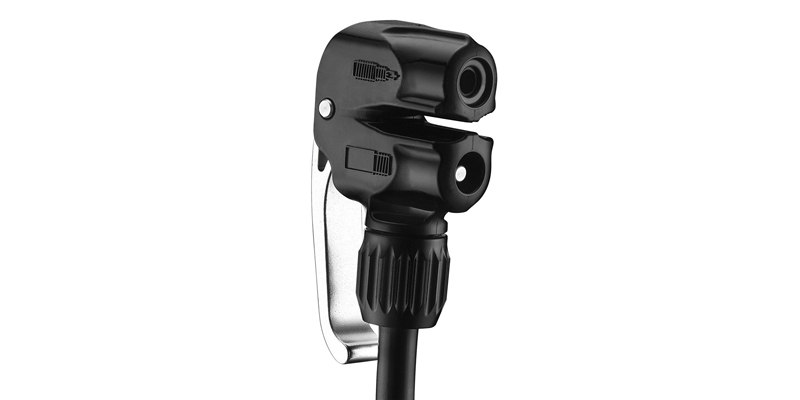
Lezyne dual valve pump head. | Image source: Jenson USA
There’s very little difference when it comes to the mechanics of a Schrader valve vs Presta valve pump. Both use a tube-shaped air chamber with a handheld compressor or foot pump to push air through the hose and into the valve.
Best Bike Pumps Reviewed: Mini, Floor, and CO2 Options for Optimal Tire Pressure
The only real difference is at the valve connector, the bit that you attach or hold against the valve when pumping. A Schrader pump has a larger head to fit the wider barrel of the Schrader valve, whereas Presta pumps have a smaller hole with a rubber gasket that fits snuggly around the valve.
The Schrader pump also has a pin that pushes down on the spring-loaded check valve and lets air flow through the valve.
These days, most foot pumps have a twin dual-head fitting for both Presta and Schrader, and most mini-pumps and frame pumps have a swappable adapter head that can be flipped around to fit one or the other.
Shop Bike Pumps
JensonUSA.com
Presta vs. Schrader Valve Adapter: Do You Need One?

As mentioned, most pumps come with an adapter or dual-head designs for both Schrader and Presta, but unless you have multiple bicycles, you probably won’t need both. However, it never hurts to keep a dual-head pump or valve adapter with you in case you encounter somebody on the road who needs to borrow your pump. Many Presta tubes come with a Presta to Schrader valve adapter.
Additionally, it could be beneficial for road riders to carry a Presta to Schrader adapter in addition to a mini pump. The reason is that it’s hard to reach high tire pressure (~100 psi) with a mini pump, so an adapter would allow you to do so with an air compressor at a service station. But this also depends on the type of pump.
Can You Use a Wrong Tube in Your Tire?
Tubes are made of very stretchy rubber, so they’re quite flexible when it comes to sizes. It’s best to always use the correct tube size for your tires, but in emergencies, you can use a tube of a slightly different size. For example, a 700x25c tube could work in a 700x32c tire, but anything larger than that (i.e. 700x40c) could be an issue.
Similarly, a 27.5″ tube could work in a 29″ tire, but stretching a 26″ tube to a 29″ tire could give you issues. If you have to use an incorrect size tube in an emergency, change it to the correct size as soon as possible.
FAQ
What is a Schrader valve?
What is a Presta valve?
How to pump a Schrader valve?
How to inflate a Presta valve?
How to remove a Schrader valve?
How to remove a Presta valve core?
How to use a Presta valve adapter?
Do you need a special pump for Presta valves?
Read Next
A Complete Bike Wheel Size Guide

